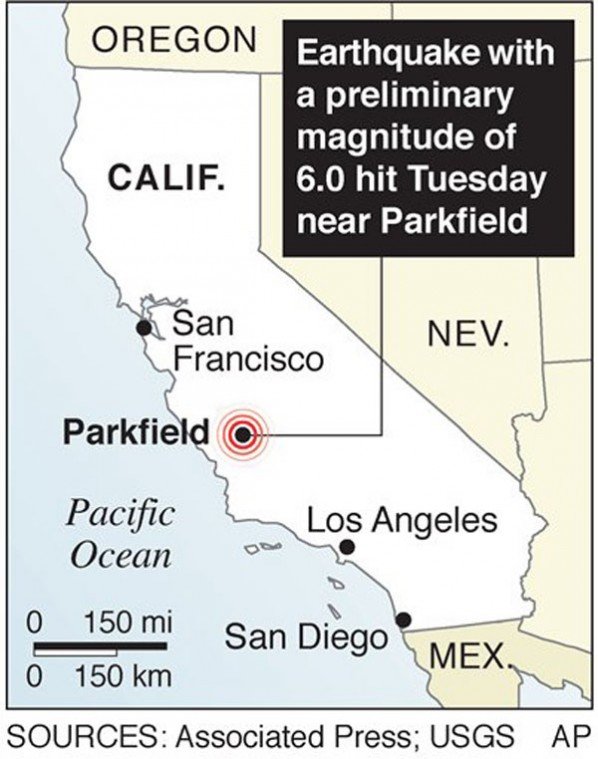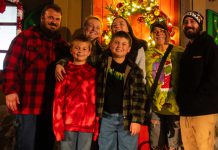By Matthew Fordahl Associated Press
Parkfield
– A strong earthquake with a preliminary magnitude of 6.0 struck
Tuesday along the San Andreas fault in a place known as
California’s earthquake capital. Some structures were damaged in
the immediate area, but no injuries were immediately reported.
By Matthew Fordahl Associated Press
Parkfield – A strong earthquake with a preliminary magnitude of 6.0 struck Tuesday along the San Andreas fault in a place known as California’s earthquake capital. Some structures were damaged in the immediate area, but no injuries were immediately reported.
The earthquake, which struck at 10:15am, was centered about halfway between San Francisco and Los Angeles, seven miles southeast of Parkfield and 21 miles northeast of Paso Robles, according to the U.S. Geological Survey.
Spokespeople for the Gilroy Police Department, Gilroy Fire Department, the California Highway Patrol, Santa Clara County Sheriff’s Department all said Tuesday, they had received no calls reporting damages or injuries.
Morgan Hill police dispatchers said no one called to report feeling the earthquake. Up the street at the Santa Clara County Fire Department’s El Toro station, Battalion Chief Don Jarvis said not only had they had no calls, they didn’t feel the quake and hadn’t known about it.
More than 160 aftershocks followed in quick succession, one with a preliminary 5.0 magnitude and four others at 4.1 or above. The initial, 10-second quake was felt along a 350-mile stretch, as far north as Sacramento and as far south as Santa Ana.
“Things were shaking so bad you couldn’t tell where to go next,” said Parkfield Vineyard owner Harry Miller, who grows 170 acres of wine grapes in Parkfield.
Five or six of Miller’s buildings – including his home – were damaged by the quake, which also tipped over about 300 cases of wine. Most of his water pipes burst, and so much was thrown out of place in the ranch’s mechanic shop that he couldn’t even walk in to assess the damage, he said.
“I looked at the 10,000-gallon water tank, and there was water shooting 30 feet away,” said Miller, who ran to the lawn with his wife when the first wave hit.
Four hours after the main earthquake, the state Office of Emergency Services hadn’t received reports of injury or major damage.
Scientists put the chance of another similar or larger quake striking in the same area this week at 5 percent to 10 percent, said USGS geophysicist Andrew Michael.
Laurie Batson, of Parkfield, was out horseback riding with her husband on their ranch when the quake struck. When they returned to her house to check for damage, they saw a couple of cords of recently stacked wood had been knocked over and a horse trailer was knocked off its block. But nothing could have prepared them for what they saw when they went inside.
Two large brick fireplaces in their home had collapsed into their living room, leaving large chunks of concrete and brick strewn across the floor. Glasses from their kitchen cabinets flew out and crashed to the floor. The television set was face down, cracked, on the ground. And in the kitchen, some debris fell on to their stove turning it on high.
Tuesday’s quake, which occurred at a depth of 4.9 miles, was a “strike-slip quake,” which means it caused the ground to move horizontally, said Kate Hutton, a seismologist at the California Institute of Technology in Pasadena.
Parkfield, population 37, is one of the world’s most seismically active areas, sitting at the boundary of a creeping section and locked section of the San Andreas fault.
Christy Gieseke, 49, a rancher in nearby San Miguel, said the earthquake spooked her horses – and her as well.
“I had just got out of the shower and ran outside in my dishtowel. My chandelier was shaking. You could hear the ground,” Gieseke said. “It was totally scary. I came in and I decided I better get my clothes on real quick.”
The very few residents of Parkfield – a half-dozen buildings on either side of a street in a valley surrounded by oak-studded hills – pride themselves on the area’s seismic activity. Drivers into town pass a sign reading “Now entering the North American plate.”
“The thing about the San Andreas fault is, you have to appreciate it because it’s what made California the most spectacular state there is,” said John Varian, a lifelong resident and owner of the Parkfield Cafe, where food spilled out of the cupboards Tuesday. “I’ll take my earthquakes over those hurricanes any day.”
Staff writers Katie Niekerk and Carol Holzgrafe contributed to this report.














